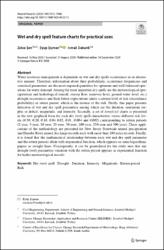| dc.contributor.author | Şen, Zekai | |
| dc.contributor.author | Şişman, Eyüp | |
| dc.contributor.author | Dabanlı, İsmail | |
| dc.date.accessioned | 2020-11-30T06:09:41Z | |
| dc.date.available | 2020-11-30T06:09:41Z | |
| dc.date.issued | 2020 | en_US |
| dc.identifier.citation | Şen, Z., Şişman, E. ve Dabanlı, İ. (2020). Wet and dry spell feature charts for practical uses. Natural Hazards, 104(3), 1975-1986. https://dx.doi.org/10.1007/s11069-020-04257-5 | en_US |
| dc.identifier.issn | 0921-030X | |
| dc.identifier.issn | 1573-0840 | |
| dc.identifier.uri | https://dx.doi.org/10.1007/s11069-020-04257-5 | |
| dc.identifier.uri | https://hdl.handle.net/20.500.12511/6056 | |
| dc.description.abstract | Water resources management is dependent on wet and dry spells occurrences in an alternative manner. Therefore, information about their probabilistic occurrence frequencies and statistical parameters are the most required quantities for optimum and well-balanced operations for water demand. Among the most important dry spells are the meteorological (precipitation) and hydrological (runoff, stream flow, reservoir level, ground water level, etc.) drought occurrences and their future expectations under a certain level of risk (exceedance probability) or return period, which is the inverse of the risk. Firstly, this paper presents detection of wet and dry spell parameters among which are the duration, maximum surplus or deficit, magnitude, and intensity. Secondly, a set ofbeneficialcharts is presented in the new graphical form for each dry (wet) spell characteristic versus different risk levels (0.50, 0.20, 0.10, 0.04 0.02, 0.01, 0.004 and 0.002) corresponding to return periods (2-year, 5-year, 10-year, 25-year, 50-year, 100-year, 250-year and 500-year). These applications of the methodology are presented for New Jersey Statewide annual precipitation and Danube River annual discharge records each with more than 100 years records. Finally, it is found that the mathematical relationship between each wet and dry spell parameter and the return periods abide with exponential function, which appears on semi-logarithmic papers as straight lines. Consequently, it can be generalized for the study area that any drought (wet) parameters variation with the return period appears as exponential function for hydro-meteorological records. | en_US |
| dc.language.iso | eng | en_US |
| dc.publisher | Springer | en_US |
| dc.rights | info:eu-repo/semantics/embargoedAccess | en_US |
| dc.subject | Dry (Wet) Spell | en_US |
| dc.subject | Drought | en_US |
| dc.subject | Duration | en_US |
| dc.subject | Intensity | en_US |
| dc.subject | Magnitude | en_US |
| dc.subject | Return Period | en_US |
| dc.subject | Risk | en_US |
| dc.title | Wet and dry spell feature charts for practical uses | en_US |
| dc.type | article | en_US |
| dc.relation.ispartof | Natural Hazards | en_US |
| dc.department | İstanbul Medipol Üniversitesi, Mühendislik ve Doğa Bilimleri Fakültesi, İnşaat Mühendisliği Bölümü | en_US |
| dc.department | İstanbul Medipol Üniversitesi, Rektörlük, İklim Değişikliği Araştırmaları Araştırma Merkezi (İKLİMER) | en_US |
| dc.authorid | 0000-0003-2754-5492 | en_US |
| dc.authorid | 0000-0003-3696-9967 | en_US |
| dc.authorid | 0000-0003-3108-8167 | en_US |
| dc.identifier.volume | 104 | en_US |
| dc.identifier.issue | 3 | en_US |
| dc.identifier.startpage | 1975 | en_US |
| dc.identifier.endpage | 1986 | en_US |
| dc.relation.publicationcategory | Makale - Uluslararası Hakemli Dergi - Kurum Öğretim Elemanı | en_US |
| dc.identifier.doi | 10.1007/s11069-020-04257-5 | en_US |
| dc.identifier.wosquality | Q2 | en_US |
| dc.identifier.scopusquality | Q1 | en_US |


















